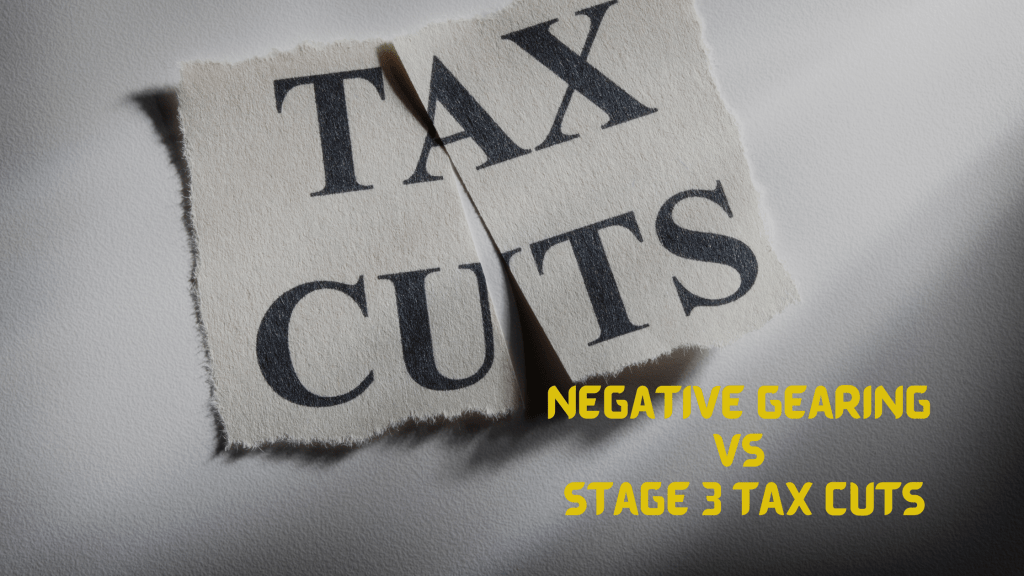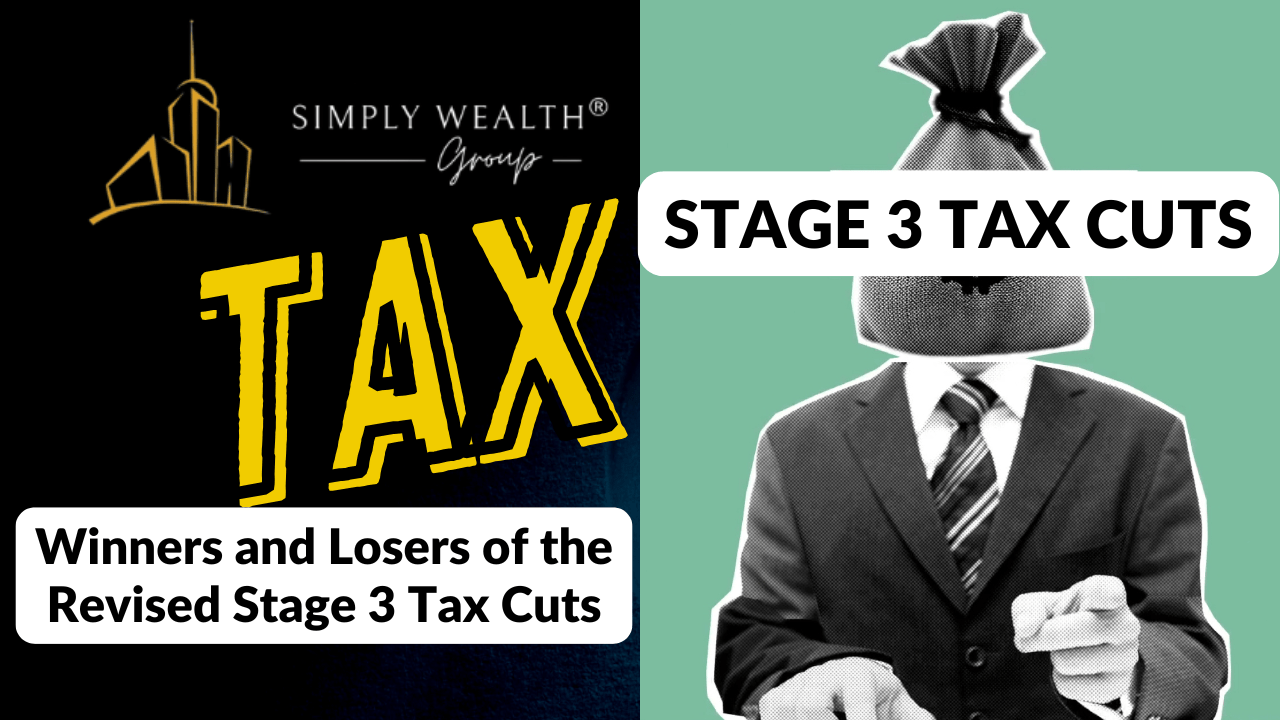Stage 3 Tax Cuts vs. Negative Gearing: What’s More Beneficial for Property Investors?
Navigating the world of property investment can be complex. Especially when it comes to understanding the financial implications of different tax strategies.
In Australia, two key considerations are Stage 3 tax cuts and negative gearing. Both have potential benefits for property investors, but which is more advantageous?
Negative gearing allows investors to deduct property investment losses from their taxable income. It’s a strategy that’s been part of the Australian property market for decades.
On the other hand, Stage 3 tax cuts aim to reduce personal income tax rates. This could increase disposable income, potentially stimulating economic growth and affecting the property market.
In this article, we’ll delve into the details of both strategies. We’ll compare their benefits, helping you make informed decisions about your investment strategies.
 Understanding Negative Gearing
Understanding Negative Gearing
Negative gearing occurs when the expenses on a property surpass the rental income it generates. This loss can then be subtracted from the investor’s total taxable income, effectively reducing tax liabilities.
Australia’s property market has long been influenced by negative gearing. In the 1980s, it was adopted to encourage property investment and has since remained a popular strategy. Many investors use it to offset income from high tax brackets.
The tax deductions from negative gearing can be significant. Investors can claim expenses such as interest on loans, property management fees, and maintenance costs. These deductions can make costly properties more affordable.
However, negative gearing is a contentious topic. Critics argue it inflates property prices, reducing housing affordability. As a result, there’s an ongoing debate about its role in the current housing crisis.
In practice, negative gearing strategies vary. Some investors choose high-growth locations with higher potential losses, banking on long-term capital gains. Others focus on cash flow-positive properties, integrating negative gearing selectively. These real-life scenarios highlight its diverse applications.
Exploring Stage 3 Tax Cuts in Australia
Stage 3 tax cuts in Australia are scheduled to commence in the near future. These cuts aim to simplify the tax system by reducing the number of tax brackets. The top marginal tax rate will decrease, providing more Australians with a lower, uniform tax percentage.
The Stage 3 tax cuts will noticeably affect personal income tax rates and the amount of money people have to spend. With reduced taxation on higher income, more funds will be available for consumption and investment. This is particularly beneficial for property investors looking to reallocate funds.
By easing the tax burden, these cuts have the potential to boost economic growth. Increased disposable income may result in higher consumer spending, which could invigorate multiple sectors, including housing. As property demand rises, so might property values, impacting investment returns.
For investors, these cuts could necessitate a rethink of strategies. Tax cuts often make other investments more appealing, prompting property investors to diversify portfolios. Additionally, the changes might modify risk assessments and willingness to invest in properties with negative gearing.
However, the future of Stage 3 tax cuts holds uncertainty. Shifting political climates and economic variables can influence policies, thereby affecting their longevity and extent. Investors must stay updated and adapt strategies accordingly to navigate these potential changes.
Comparing the Benefits: Negative Gearing vs. Stage 3 Tax Cuts
Understanding the financial benefits of negative gearing versus Stage 3 tax cuts requires examining both short-term and long-term perspectives. In the short run, negative gearing offers immediate tax deductions on losses, reducing taxable income. Over time, however, Stage 3 tax cuts promise broader savings through reduced marginal tax rates, affecting overall financial positioning.
Capital gains tax plays a significant role in property investments. For negatively geared properties, capital gains tax can offset long-term gains, impacting net returns. Stage 3 tax cuts, by lessening income tax burdens, indirectly allow for more strategic planning around capital gains.
Investors’ marginal tax rate significantly affects the choice between negative gearing and tax cuts. Investors in higher tax brackets can achieve considerable tax savings through negative gearing. Conversely, Stage 3 tax cuts aim to flatten tax burdens, potentially leveling the playing field for lower and middle-income investors.
Evaluating risks and rewards is crucial for financial planning. Negative gearing often results in short-term cash flow challenges yet offers potential for long-term portfolio growth. Meanwhile, tax cuts may boost immediate cash flow, influencing the balance of portfolio diversification and risk-taking.
Current market conditions also affect these strategies. In high-demand property markets, negative gearing might offer advantageous returns due to property appreciation. In contrast, Stage 3 tax cuts could encourage broader economic participation, shifting the investment focus from solely property to include other asset classes.
Navigating these complex decisions often requires professional advice. Financial advisors can provide guidance tailored to specific tax circumstances and investment goals. They help investors weigh the benefits and drawbacks of each strategy, ensuring financial plans align with individual needs and market realities.

Financial Planning and Tax Considerations for Property Investors
Understanding marginal tax rates is fundamental for investors utilizing negative gearing or considering Stage 3 tax cuts. Marginal tax rates determine how much tax is paid on additional income, influencing the effectiveness of tax strategies. Tax deductions can further enhance these strategies, reducing the overall taxable income.
Capital gains tax significantly impacts property investment decisions. When selling a property, understanding potential capital gains tax is crucial in evaluating investment profitability. Ensuring an informed approach to timing sales can mitigate tax liabilities, enhancing net returns.
Interest rates play a pivotal role in the cost of borrowing for property investments. Lower rates can increase the appeal of negative gearing by reducing borrowing costs and boosting potential returns. Monitoring fluctuations helps investors adapt strategies to maximize profit.
A structured investment plan is vital for aligning property investments with financial goals. This plan should consider both short-term cash flow and long-term capital growth strategies. Including tax considerations ensures a holistic approach to investment planning.
Effective record-keeping and documentation are essential for property investors using tax strategies. Detailed records ensure accuracy in tax filings and the ability to substantiate deductions. Organized documentation simplifies tax time and avoids potential issues with compliance.
Seeking professional advice is invaluable for navigating complex tax landscapes. Financial advisors provide expertise in aligning investment choices with tax requirements and personal goals. Their insights can optimize tax benefits and guide investors through legislative changes and financial challenges.
In summary, key considerations for property investors include:
- Understanding marginal tax rates and deductions
- The role of capital gains tax in investment decisions
- Monitoring interest rates and borrowing costs
- Developing a structured investment plan
- Maintaining accurate records and documentation
- Seeking professional advice for complex tax strategies
The Impact of Market and Economic Factors
Economic cycles greatly influence tax strategies and property investments. During boom periods, property values rise, potentially increasing capital gains. Conversely, in downturns, investors may focus on maximizing tax deductions through negative gearing to offset lower returns.
The success of negative gearing often hinges on the property’s location and type. Prime locations with high rental demand can yield better cash flow, enhancing the benefits of negative gearing. Property type, such as residential versus commercial, also impacts potential returns and tax deductions.
Interest rates are a crucial factor in property investment. Lower interest rates reduce mortgage costs and improve cash flow, making negative gearing more appealing. However, rising inflation can erode returns, necessitating adjustments in investment strategies.
Government policy plays a significant role in the property market. Policies affecting housing supply, tax incentives, or restrictions on negative gearing can sway investor behavior and market dynamics. Staying informed about policy changes is essential for strategic planning.
Demographic trends and consumer confidence affect property demand and investment viability. Population growth can spur demand for housing, influencing rental yields and property values. High consumer confidence often correlates with increased property investment activity.
Key market and economic factors to consider include:
- Economic cycles and their effect on tax strategies
- The influence of property location and type on gearing success
- The impact of interest rates and inflation on investment returns
- Government policies affecting property investment and tax regulations
- Demographic trends shaping demand and consumer confidence
Case Studies: Real-Life Scenarios of Investors
Considering real-life scenarios can clarify the options available to property investors in Australia. One scenario reveals how negative gearing performs during different market conditions. In a strong market, investors often benefit from increased rental income and higher property values. Conversely, in a weak market, negative gearing may lead to significant tax deductions, which help mitigate financial losses.
Stage 3 tax cuts could impact various income brackets differently. For high-income investors, reduced taxes could mean increased disposable income and more funds available for property investment. Lower-income investors might experience modest savings but still benefit from an overall tax reduction.
Negative gearing can support long-term wealth building. It allows investors to offset losses against income, potentially accumulating properties that appreciate over time. With a long investment horizon, this strategy can lead to substantial gains, especially when the property market rebounds.
Retirement planning is closely tied to Stage 3 tax cuts. Investors approaching retirement might leverage tax savings to boost superannuation contributions or reduce mortgage debt. This approach could lead to a more secure retirement with less financial strain.
Diversification is critical in property investment. Stage 3 tax cuts and negative gearing can both play roles in a balanced portfolio. Investors may allocate funds across different asset classes, such as stocks or bonds, alongside property investments to manage risk and potentially enhance returns.
The interplay between tax cuts, negative gearing, and superannuation can be complex. Investors need to consider how these elements align with their financial goals. Professional advice often helps in navigating these layers, ensuring strategic decisions align with personal objectives.

Conclusion: Making an Informed Decision
Choosing between Stage 3 tax cuts and negative gearing requires careful consideration of several factors. Understanding the tax implications and potential financial benefits is crucial for property investors. It’s important to weigh short-term gains against long-term strategies, including capital gains and cash flow.
Aligning investment strategies with personal financial goals can lead to better decision-making. Whether aiming for long-term wealth accumulation or maximizing immediate tax benefits, strategies should reflect individual objectives. Consider factors like your risk tolerance, investment horizon, and financial situation.
Staying informed about legislative changes is vital for maintaining effective strategies. Tax laws and economic conditions can shift, influencing investment decisions. Regularly updating your knowledge and working with professionals can help ensure that your strategies remain relevant and effective in a dynamic market. Always be proactive in adapting your approach to align with new regulations or economic trends.
Additional Resources
For further insights and guidance, consider exploring the following resources:
- Australian Taxation Office (ATO) Guidelines for understanding tax regulations.
- Simply Wealth Group for latest tax education updates.
- Negative Gearing Insights
- Stage 3 Tax Cuts Unmasked













